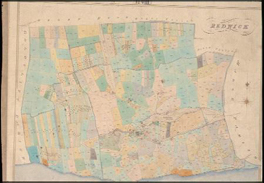Historic Landscape
Characterisation
The Gwent Levels
07 Redwick Broadmead
07 Redwick Broadmead character area: "regular landscape"
derived from the Parliamentary enclosure of open-fields.
(Photo: GGAT Redwick CSmap)
Click here for a character area map
Broadmead is first recorded in 1422. It was a large tract of meadow, divided into strips which were not defined by ditches; hence it was known as an "open field". Piecemeal enclosure probably started by the sixteenth century on the eastern side, but it remained largely unenclosed until a Parliamentary Act of 1858; the present pattern of roads and fields for the most part date to that period.
This was the communal meadow of Redwick village, and is mentioned in innumerable documentary sources. It survived to be mapped in 1831.
Key historic landscape characteristics
Regular field pattern of large rectangular fields, drainage features
(reens, ridgeing/surface drainage, bridges, medieval drainage channels),
seawall, single green lane (pollards) without waste
An area bounded by Elver Pill Reen/Porton (area 4) to the west, Grangefield (area 8) to the north, Windmill Reen (area 6) to the east and the coast to the south.
This homogeneous and uniform landscape is dominated by a pattern of mainly large, rectangular fields which replaced the earlier open field strips. The only road, Mead Lane, is a very straight green lane which lacks any roadside waste.
There is a very limited range of other landscape features, notably some fine bridges along Mead Lane. Two major medieval artificial drainage channels, Elver Pill and Windmill Reens, lie to the west and east. The sea wall to the south has a stone rubble racing and concrete wave return wall. A few fields have ridging, and occasional ill-developed grips. Pollards are mainly restricted to hedges beside the green lane.
For the Levels, this is a very rare single period landscape, and the most extensive parliamentary enclosure of former open fields. As such it is one of the few landscapes for which an absolute date of origin can be attributed. A major characteristic is the very limited range of landscape features, notably the predominance of large rectangular fields and lack of settlement. Its condition is generally good. Hedge maintenance, however, is very diverse.
This landscape has a very high integrity and coherence relating to its
nineteenth century origins. It also demonstrates how landscapes were transformed
through Parliamentary enclosure.
